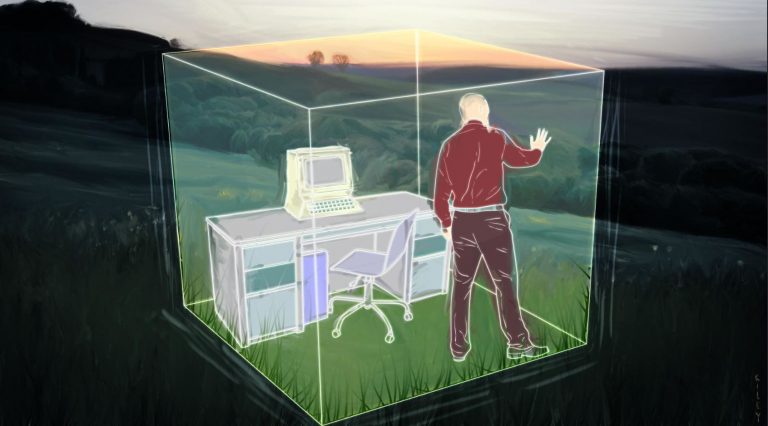- Home
- Critical Decade
- HI Climate Action
- HI Commission
- HI Resources
- HI Equity
- HI Events
Teleworking in Paradise: Benefits for a Better Normal

 Compared to other first world countries, American workplaces employ notoriously strict policies when it comes to allowing for flexible working conditions such as maternity leave, vacation, and teleworking. Not surprisingly, the typical American office has barely changed for nearly a century. Until COVID-19 changed everything, including how we work.
Compared to other first world countries, American workplaces employ notoriously strict policies when it comes to allowing for flexible working conditions such as maternity leave, vacation, and teleworking. Not surprisingly, the typical American office has barely changed for nearly a century. Until COVID-19 changed everything, including how we work.
On March 23rd, Governor Ige ordered abrupt closures of workplaces across Hawai‘i. Some were ready to make the transition, but many large organizations were unprepared. Legislators bemoaned that a large number of state workers were idle because of unpreparedness for telework. As more workers learned to use telecommuting platforms and moved to restore government operations, the benefits of this new system became obvious. Workplaces are now reporting higher increased productivity, higher morale, and huge savings on office maintenance and running costs.

Sources around the world tell us that the pandemic has led to sharp declines in greenhouse gas emissions (GHGs), leading climate enthusiasts to rejoice. In the US, emissions have fallen by an estimated 8%, while globally they have been reduced by a whopping 17%. As we reopen, and get back to “normal” telework is an important tool that can not only help with reducing greenhouse gas emissions in the fight to address climate change, it could also provide some relief in traffic congestion and overall improved quality of life in Hawai‘i, and continuity of government operations in the face of future disruptions.
Maybe in a #betternormal, we would not spend hours of precious free time commuting, and instead use telework to maximize our time spent enjoying all that our beautiful state has to offer. On clogged streets and unreliable transit, Hawaiian residents were struggling to get to work even before the pandemic. In a recent study of 20 large American cities, Honolulu ranked 9th for congestion. It further details that the city averages a commute time of 29.1 mins (higher than the national average or 26 mins). Since social-distancing rules will prevent crowding on public transit, Honolulu may look even more like a parking lot as we return to and expand the single occupancy vehicle model. Already, rideshare and micro-mobility companies are reporting record lows in usership. We must be wary of taking too many steps backward after the crisis; decreasing the number of cars on the road while increasing green transportation options remain important components for making Hawai‘i “climate ready” as we get to a new and better normal.

Maybe in a #betternormal, we would realize we do not need all those office buildings with their big parking lots that take up all this space. During peak hours in Honolulu, which occur Monday through Friday in the middle of the business day, there are about 13,000 vacant parking spaces, which equates to a 71% occupancy rate. We could be using this space for housing people, not cars. Students from the Savannah College of Art and Design transformed an empty parking garage into a beautiful, affordable, tiny home community. Tiny homes are quick and easy to build, with an affordable base price of $40,000. At roughly 150-170 square feet, a footprint fits nicely into a single parking space.

Maybe in a #betternormal, telework will allow us to save money, increase well being, productivity, stay healthy, and become cutting edge. If the US were to embrace telecommuting, it could save over $650 billion a year, would reduce oil consumption by 280 million barrels per year, and reduce emissions by the equivalent of removing 9 million cars from roads. According to the American Psychological Association, studies have shown that remote workers report higher morale, lower stress levels, and are absent less often.
And so, while in a #betternormal, our coworkers may not need to come in at all, it would also make us more resilient and better prepared to keep government working even as future crises unfold.
Check out Casey Ambrose’s write-up on this piece for the Hawaiʻi Department of Transportation Monthly Newsletterʻs July 2020 issue!
Note: The State is in the process of updating its telework policy. It is important to recognize, however, that telework is only one tool in a larger suite that address climate change. Studies have shown that it is not entirely clear that telework alone saves GHG emissions or reduces the overall miles traveled for a commute. For maximum GHG reduction, telework needs to be embedded and connected to programs that encourage parking cashout, and transit, bike and pedestrian commute. In addition, nesting telework options within other commute benefits may help to address any skewed equity impacts since most blue collar jobs are not conducive to telework.
Disclaimer: The views and positions expressed on HIBlog are those of the authors and do not necessarily reflect the views and positions of the Hawai‘i Climate Commission or the State of Hawai‘i. If you notice an error in our research or have concerns about quality, please contact Anukriti Hittle at [email protected]